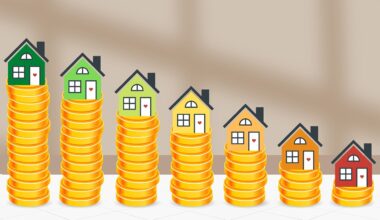Decoding Mortgage Loans: A Beginner’s Guide
Understanding mortgage loans can be daunting, especially for first-time buyers. A mortgage is essentially a loan specifically for buying property, secured against the value of that property itself. Knowing how these loans function is crucial in determining the long-term financial consequences of home ownership. To start, mortgage loans are divided into various categories, each with distinct features and benefits. Here are the key types to familiarize yourself with:
- Fixed-rate mortgages: These maintain the same interest rate throughout the loan term.
- Adjustable-rate mortgages (ARMs): These have fluctuating interest rates that can change periodically.
- Government-backed loans: FHA, VA, and USDA loans provide options with lower requirements.
- Jumbo loans: These exceed the conforming loan limits and typically require higher credit scores.
It’s essential to evaluate how these options align with your financial situation and home ownership goals to navigate the process effectively. With the right information, you can make better decisions and secure a mortgage loan that fits your needs.
Before diving into the application process, it’s beneficial to establish your borrowing capacity. Lenders assess your financial situation based on various factors, including your income, credit score, and debt-to-income (DTI) ratio. A good credit score is often pivotal, as it signifies your reliability in repaying debts. Aim for a score of 700 or higher to secure favorable interest rates and terms. Additionally, understanding your DTI ratio is critical; lenders typically prefer a DTI of 43% or below. It’s calculated by dividing your total monthly debt payments by your gross monthly income. Keeping your debts in check can pave the way for a better mortgage offer. Further, having a stable income source greatly aids in gaining lender confidence. Prepare necessary documents like tax returns, pay stubs, and bank statements for your application. By presenting a solid financial picture to mortgage providers, you will increase your chances of approval and access to competitive loan options tailored to your unique needs.
The Mortgage Application Process
The mortgage application process can seem complex, but breaking it down can simplify things significantly. Initially, choose multiple lenders to compare rates and terms, ensuring you find the most advantageous deal. After selecting a lender, they will begin the pre-approval process. This involves verifying your financial credentials and issuing a pre-approval letter, defining how much you can borrow. Once pre-approved, you can confidently shop for homes within your limits. After an offer is accepted, the lender will conduct an in-depth review of your financial information and order an appraisal of the property to gauge its value. You’ll also undergo a thorough documentation review, which includes verifying your employment history and debts. A sound understanding of this process can alleviate stress and help expedite your journey towards obtaining a mortgage. Throughout, maintain open communication with your lender to resolve any issues promptly. Having all your financial documents ready can streamline processing time and keep the transaction on track for a smooth closing.
Once your mortgage application is approved, the closing process will begin. Closing, sometimes referred to as settlement, is the final step in securing your loan and officially transferring property ownership. During this phase, you’ll be required to review and sign several important documents, including the loan agreement and the deed. Inspect these documents closely to ensure their accuracy and understand your responsibilities. On closing day, be prepared for additional expenses, such as closing costs, which can include loan origination fees, appraisal fees, title insurance, and other related expenses. Typically, closing costs range from 2% to 5% of the home’s price. It’s crucial to budget for these costs as they can significantly impact your overall home purchase budget. Once signed, you will receive keys to your new home, marking the beginning of your journey as a homeowner. Make sure you have adequate insurance in place, as it’s often required by lenders to protect both your investment and their interests.
Understanding Mortgage Payments
The next step is to comprehend the elements that contribute to your mortgage payments. Mortgage payments usually consist of four main components, known as PITI, which stands for Principal, Interest, Taxes, and Insurance. The principal is the amount borrowed, while interest is the cost of borrowing that money, typically expressed as an annual percentage rate (APR). It’s essential to understand how your interest rate affects the total cost of your loan over time. Additionally, property taxes may be included in your monthly payment, reflecting your contribution to local government services. Lastly, homeowners insurance is often mandated by lenders to protect the property from damages and liabilities. Regularly reviewing and potentially refinancing your mortgage can also lead to reduced payments over time. As property value appreciates or income increases, keep monitoring your situation to explore options that may lower your costs further. Being well-informed about these elements will empower you to manage your mortgage successfully and plan for financial security.
One of the most profound advantages of understanding mortgage loans is the potential for building equity over time. Equity represents the portion of your property that you actually own, and it increases as you repay your loan. With the average American homeowner’s equity growing, it’s crucial to recognize how to maximize this wealth-building aspect. As property markets improve or through home renovations, your property’s value could rise, further enhancing your equity position. Several strategies can help in growing equity, like making extra principal repayments or refinancing to favorable terms. Additionally, avoid withdrawing equity through home equity loans or lines of credit unless absolutely necessary. Your goal should be to increase the home value and reduce the outstanding mortgage balance, ensuring a healthy equity position. This is a vital component of your financial portfolio, and as equity accumulates, it opens doors to further investments or allows security during retirement. Monitor your home’s performance along with the market to establish an optimal plan and make informed refinancing decisions.
The Risks and Challenges of Mortgages
While a mortgage can be an effective pathway to homeownership, several risks and challenges should be taken into account. Variables such as fluctuating interest rates can affect your monthly payments, especially with adjustable-rate loans. It’s imperative to understand the terms of your mortgage fully to avoid unexpected increases that could strain your budget. Foreclosure is another serious risk associated with mortgages, which occurs when a borrower cannot make their payment obligations, leading to the lender reclaiming the property. Maintaining consistent payments and establishing an emergency fund can aid in mitigating this risk. It’s also vital to be aware of predatory lending practices, which can lead to unmanageable debt. Seek guidance from reputable advisors or financial coaches to avoid common pitfalls. Convey your concerns and ensure clear communication throughout the mortgage process to protect your financial health. By proactively addressing these challenges, you can navigate the mortgage landscape with confidence and ultimately ensure stable homeownership.
As you journey through mortgage loans, remember to leverage available resources and tools for making informed decisions. Many online calculators can assist in estimating monthly payments, understanding loan terms, and comparing various mortgage options. Educate yourself continuously on the changing market trends and factors that may influence your financing options. Additionally, connect with mortgage professionals who can provide valuable insights tailored to your specific circumstances. Local real estate workshops and community seminars also offer education on the mortgage process, helping potential buyers feel empowered. Consider working closely with real estate agents and mortgage brokers who are knowledgeable about the local market intricacies. A strong support system ensures you remain well-informed and confident in your choices. Ultimately, achieving your home-owning dreams is about making thoughtful decisions and understanding the underlying processes. With patience and dedication, you can navigate the world of mortgage loans to find a solution that best aligns with your financial aspirations.


